Connect With Us
Nail Fungus
What IS toenail fungus?
 The medical term for Toenail Fungus is Onychomycosis. It is the most common disease of the nails.
The medical term for Toenail Fungus is Onychomycosis. It is the most common disease of the nails.
There are different types of nail fungus that cause the nail to change. When a toenail is infected, it may become thickened, brittle, have white spots or patches, become loose and detached from nail bed, and produce debris under the nail. Infected toenails may be sensitive or painful as well.
The toenail may be yellow, black, green, or white. This can mean fungus, yeasts, molds, and/or bacteria are present.
How do you get Toenail Fungus?
The most common cause is plain old aging. Others ways you can get nail fungus are:
- Going barefoot in public places (swimming pools, gym locker rooms, etc.)
- Having Athlete's Foot (the same fungi that cause nail fungus can cause Athlete's Foot)
- Nail Injury or trauma (This includes nicks and cuts from getting pedicures)
- Weak Immune System (Diabetes Mellitus, people on chemotherapy, etc.)
- Sweaty feet (Hyperhidrosis) or being in a moist environment
How do you treat Toenail Fungus?
- Topical Treatment
- Treatment
- Laser Treatment
Nail Laser Treatment
You can discuss the different treatment options with your Podiatrist to find out which one is best for you and the type of toenail fungus you have.
With any toenail fungus treatment, patience is key! It takes anywhere from 9 months to a year for your toenails to grow from base to tip. This means it could take just as long for total clearing of the nail from the toenail fungus.
How do you avoid getting Toenail Fungus?
Once you have treated your toenail fungus, doesn’t mean you are immune from getting it again! The fungus, yeasts, and molds live in the environment, and re-infection can occur at any time. Here are some simple things you can do to prevent this from happening!
Share these tips with friends and family. You too can help PREVENT FUNGUS AMONG US!!
- Avoid moist, wet environments in your bare feet. If you go to a public swimming pool or use a public shower, use shower shoes.
- If you get pedicures, ask the pedicurist not to cut your cuticles. Little nicks in the skin offer an opportunity for fungus to invade your nails.
- Use bleach to clean home surfaces where you walk barefoot, if possible. (1 part bleach to 10 parts water is strong enough to kill fungus).
- Wash bath mats often.
- Replace your socks. The colored ones, at least. You can wash your white socks in bleach (see above for strength), but toss the ones you can’t in the garbage. Even though you launder them, fungus can live in the fibers of your socks.
- Treat your shoes. Spray your shoes with Athlete’s Foot Spray. Doing this daily is most effective. Another way to treat your shoes is a SteriShoe Ultraviolet Shoe Sanitizer.
- Treat your feet. You can use an Athlete’s Foot Spray on your feet daily as well to help decrease the fungal load (amount of fungus) around your nails.
- Treat your nails. Replace your nail polish with anti-fungal nail polish. If you get pedicures, take your own anti-fungal nail polish with you. You can find the polish that Academy Foot and Ankle Specialists recommend in our office store.
- Treat yourself. Thera-Nail-TF Tablets are a dietary supplement that contain Biotin, Iron, and Zinc. This combination can increase nail strength, reduce nail breakage, improve nail structure, and smooth brittle ridges. Ask your doctor at Academy Foot and Ankle Specialists how get this today!
- If you see any signs of a toenail fungal infection, make an appointment and start treatment right away!
If you believe you’re experiencing a fungal toenail infection, we recommend that you speak with a podiatrist as soon as possible for a proper diagnosis and suggested plan for treatment.
